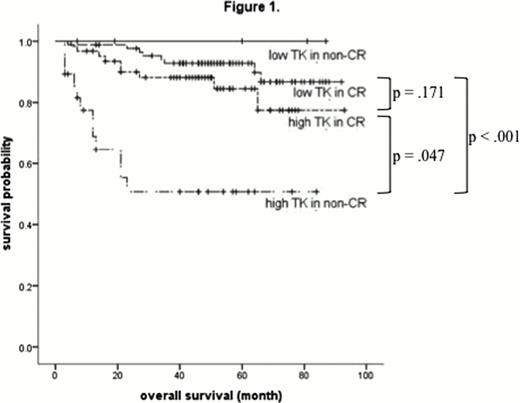Abstract
Abstract 1541
Thymidine kinase (TK) activity has been investigated as a prognostic factor in hematological malignancies, and several studies have demonstrated that a high TK activity correlates with the disease stage and provides prognostic information on overall survival (OS) and progression free survival (PFS). However, the prognostic significance of TK activity for patients with diffuse large B-cell lymphoma (DLBCL) treated with R-CHOP has not been investigated yet. The purpose of this retrospective study was to investigate the prognostic value of high TK activity compared with other laboratory findings in evaluating OS in patients undergoing R-CHOP for previously untreated DLBCL.
We retrospectively analyzed patients treated with R-CHOP for previously untreated DLBCL from September 2003 to October 2008 in our institute. We evaluated serum TK activity, C-reactive protein (CRP), lactate dehydrogenase (LDH), and hemoglobin (Hb) before R-CHOP. The cut-off for TK activity was defined as 14 IU/L. The cut-offs for CRP and LDH were defined as the upper normal limits, and the cut-off for Hb was defined as the lower normal limit. The primary endpoint was OS. The OS and PFS were analyzed by the Kaplan-Meier method, and biological prognostic factors for OS were evaluated by Cox regression analysis. Second, complete response (CR) rate was assessed by the chi square test and Fisher's exact test, comparing patients with and without the prognostic factors. All p-values reported were two-sided, and statistical significance was defined as p < 0.05.
The clinical records of 242 patients with previously untreated DLBCL were analyzed in this study. The median age of the patients was 65.2 years old (range, 23.2 – 88.1). The median levels of TK activity, CRP, LDH, and Hb were 14.0 IU/L (range, 3.0 – 1100), 0.3 IU/L (range, 0.1 – 21.2), 254.5 IU/L (range, 111.0 – 44432), and 13.1 g/dL (range, 7.7 – 17.0), respectively. Median follow-up time for all patients was 53.0 months. Median OS was 82.3 months (95% CI, 78.6 – 86.0). The OS was significantly worse in patients with high TK activity (p =.001) and anemia (p =.006) by univariate analysis. Median OS in the high and low TK activity groups was 71.7 months (95% CI 63.9 – 79.4) and 85.9 months (95% CI 81.8 – 89.9). In multivariate analysis, the OS was significantly worse in patients with high TK activity (HR 2.640, 95% CI 1.018 – 6.881; p =.046) and anemia (HR 2.228, 95% CI 1.000 – 4.967; p =.050). Median PFS was 73.9 months (95% CI, 69.4 – 78.4). The PFS was significantly worse in patients with high TK activity (p =.000), anemia (p =.005), and high LDH level (p =.010) by univariate analysis. Median PFS in the high and low TK activity groups was 57.3 months (95% CI 48.7 – 66.0) and 80.9 months (95% CI 75.5 – 86.2). In multivariate analysis, PFS was significantly worse in patients with high TK activity (HR 2.809, 95% CI 1.375 – 5.737; p =.005) and anemia (HR 1.902, 95% CI 1.033 – 3.504; p =.039). The CR and overall response rates were 81.4% and 93.0%, respectively. The OS was significantly better in patients who achieved CR than those with partial response or less. Median OS in the CR and non-CR groups was 86.1 months (95% CI 82.7 – 89.5) and 66.0 months (95% CI 53.6 – 78.3), respectively (p <.001). According to the chi square test and Fisher's exact test, the CR rates of patients with high TK activity (p <.001), high CRP (p =.004), and high LDH (p =.019) were significantly worse. The CR rates in the high and low TK activity groups were 68.9% and 92.5%, respectively. The OS for patients with high TK activity who did not achieve CR was even significantly worse than that of both low TK activity patients who did not achieve CR and high TK activity patients who achieved CR (p =.047 and <.001). However, the OS was similar in high and low TK activity group patients who achieved CR (p =.171, Figure 1).
High TK activity significantly worsened OS and PFS among patients with previously untreated DLBCL who had undergone R-CHOP. While we commonly perform R-CHOP for DLBCL as an initial treatment, our findings show that the OS becomes significantly worse in patients who do not achieve CR by R-CHOP. The OS in patients with high TK activity who did not achieve CR was significantly worse than that with both low TK activity patients who did not achieve CR and high TK activity patients who achieved CR. Our findings suggest that novel treatment strategies for previously untreated DLBCL patients with high TK activity are certainly necessary.
No relevant conflicts of interest to declare.
Author notes
Asterisk with author names denotes non-ASH members.


